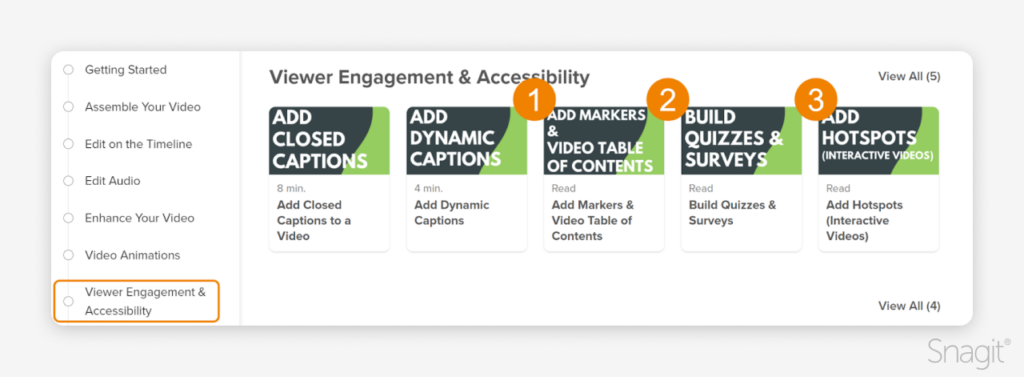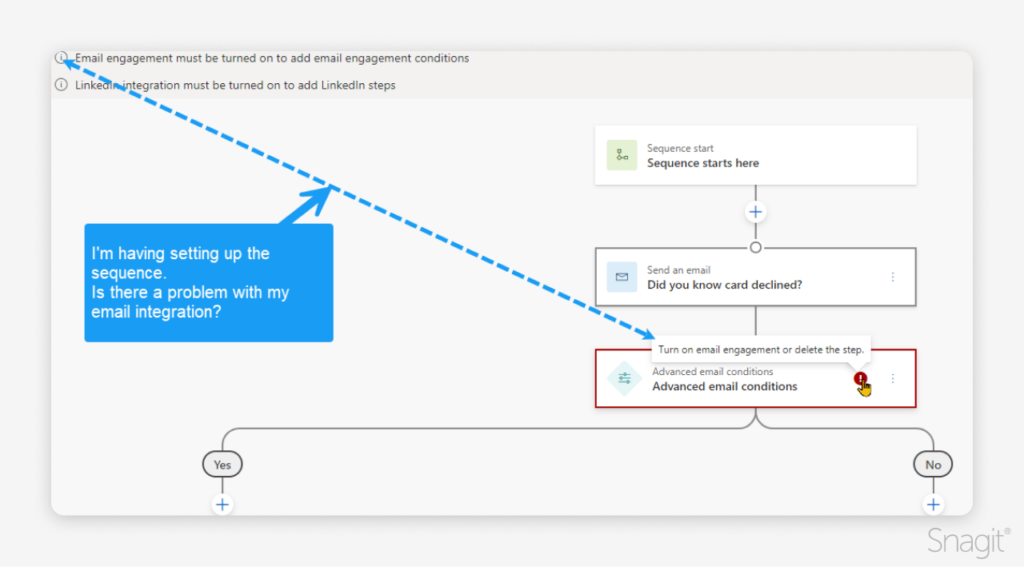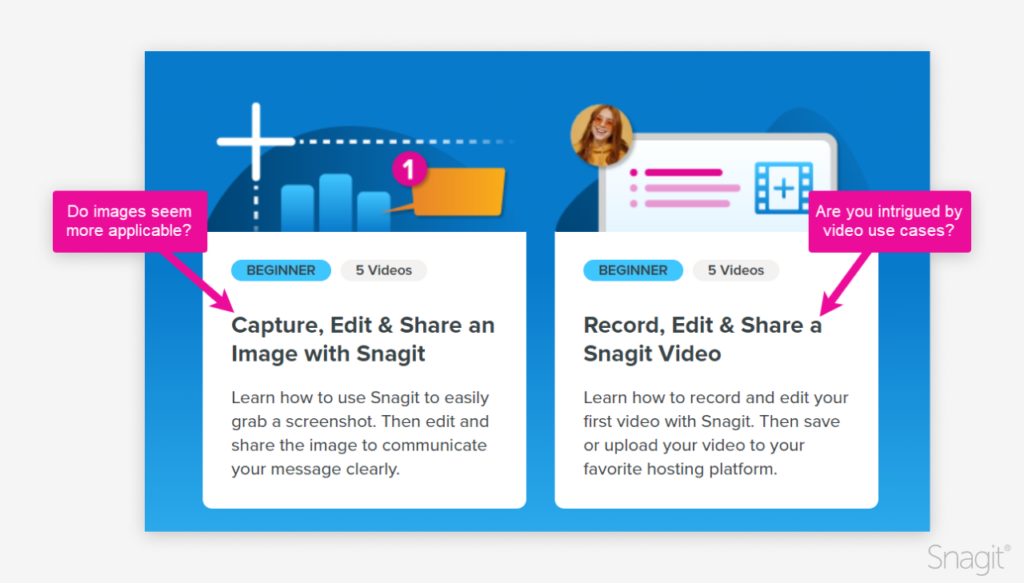It’s easier and more cost-effective to keep an existing customer than to acquire a new one. Maintaining and growing the customer’s LTV (lifetime value) is how successful companies achieve steady, year-over-year growth.
Great advice, but it doesn’t mean customer retention is easy. This article from IBM Insights says it’s harder today than ever, and therefore personalized guidance, clear instructions, and exemplary customer support are even more important. A tool like Snagit is a simple and effective way of giving your team a way to drive customer engagement and deliver an unparalleled level of personalized service.

Why is customer retention important?
When you retain happy customers, not only are you likely getting 5 times the profit over a newly acquired customer, but this base tends to generate new customers via their networks and word of mouth. It’s also much easier to introduce additional products and services to your existing customers compared to finding yet more new customers. MoEngage uses a common formula, CRR = [E-N/S] x 100, to help you calculate your retention rate.
Strategies to improve customer retention
There are a number of strategies, and something like loyalty or reward programs may work better in a commodity-like market when the customer makes repeated purchases among a breadth of similar options. Depending on your customer base or geographic location, emphasizing your company values may have a higher than typical impact.
In this article, we focus on three universal, time-tested customer retention strategies:
- Deliver excellent customer service
- Personalize the customer experience
- Implement a customer feedback loop
Deliver excellent customer service
While one-size-fits-all knowledge bases and generic tutorials have their place at scale, little is more impactful and helpful than delivering a clear and personalized response. Many companies will deliver text-based, scripted responses. They put it on the customer to navigate the options and figure it out.
Compare this to a company that equips their chat, social, and ticket-based agents with a tool like Snagit. These agents respond with a clear step-by-step image tailored exactly to the customer’s needs. They can also share an on-demand video.
Communicating in this manner means there is less back and forth, and the customer gets straight to success. Their expectations are exceeded, and they tend to leave the highest customer survey satisfaction (CSAT) scores.

Personalize the customer experience
Companies are often reactive. If the customer has an issue, then we respond. Try proactively reaching out to your loyal customers. An easy example is when you have a new or updated product or offering. Don’t just send them a faceless marketing message that the whole world gets.
Instead, make a Snagit video, from you (example). Acknowledge their investment with you and introduce the new product or service. Your tone and excitement comes through and you can tweak the message just right for your client or customer. Cut through all the noise and offers in their mailbox.
Record your screen with Snagit
Snagit makes it easy to share quick updates and how-to’s by capturing exactly what’s happening on your screen.
Get Snagit
Implement a customer feedback loop
Customer feedback can flow into your company in a number of ways. One example is customer surveys, incentivized or not. There are endless survey prompts these days. Oil change, car wash, self-checkout; all surveys. There’s nothing wrong with surveys, but response rates are in the low single-digits, and the information tends to lack actionability.
Customer-facing teams tend to have the most insight into everyday customer struggles and friction points. Equip these teams with a tool like Snagit so they can effortlessly capture, annotate, and tag examples. This is a great way to build empathy and understanding to increase customer retention. Even better, the results tend to be very actionable.

Leveraging Snagit to increase customer retention
Until now, this article has focused outward: from the company to the customer. But looking inward is a critical and under-examined aspect of customer retention. A company with ill-informed, lackluster agents without the capability to adapt to changing policies and processes is in big trouble.
A tool like Snagit is invaluable for efficiently onboarding and maintaining top-quality employees. With Snagit, a new agent can quickly send a video question or timely image of a situation to a mentor in real time. They receive “just in time” training around a policy or process that was updated that morning. Customer Care, marketing, and other teams are able to communicate the latest feature or enhancement in an “on-demand” manner and avoid calling a face-to-face meeting.
Benefit 1: Clear and effective communication
We can argue the numbers, but roughly 70% of learning and development happens through on-the-job experiences, 20% through interactions with others, and 10% through formal education. This is often called the 70/20/10 Rule as we know it today, and this is where Snagit comes in.
We learn by doing, and we learn by show and tell. Just “telling” doesn’t work too well. With Snagit, someone asks a question in Teams, Slack, Skype, email…whatever team chat tool the company uses. Maybe they include an image of what they are struggling with. Maybe they create a short video question.
Someone more knowledgeable reviews and obtains a crystal clear understanding of the problem at hand. They are able to respond accordingly, and if the answer is complex, they may include an image or video back. This is one of the cheapest and most effective ways to ‘level up’ your customer-facing teams.

Benefit 2: Efficient problem-solving
Subject matter experts (SMEs) have the potential to contribute a great deal toward your retention goals. Perhaps they have returned from a customer site visit or finally overcame a technical situation that was hurting customer satisfaction for weeks.
Using Snagit to create documentation, supported with video, can be a great way to spread this learning among teams. Unlike a text-laden email or memo, information enhanced with images and videos is more likely to be understood and remembered.
Stop repeat questions
Create clear videos and guides with Snagit so you only have to explain tasks once.
Try it Free
Benefit 3: Improved training and onboarding
This section led with the 70-20-10 “rule” and emphasized the informal side. But, guess what? Formal training is important too. There is a baseline of information that many people need to understand, and all companies have some LMS or SharePoint portal or means to deliver this training.
We’re back to the chorus here. Formal training that has compelling image and video support tends to be a lot better than text-based training. Snagit can easily elevate and supplement formal training.
Measuring the success of your retention efforts
There are different types of business and customer characteristics, so step one is to establish a baseline and test ‘what-if’ scenarios against it to ensure that the metric you use will hold up a year into the future. A software company that has a freemium model with monthly paid add-ons may care far more about the customer lifetime value than monthly active users. A provider of goods or services may focus on year over year retention rates. Below are some common industry approaches.
Customer Retention Rate (CRR)
For this measurement, a high number is a good number. The number is given as a percent. If the result is 77%, it means that over a period of time you retained (kept) 77 out of 100 customers. This calculation accounts for any new customers added during the time period as well.
The formula is:
((Total number of customers – New customers) / Prior total customers) x 100
((E – N) / S) x 100
- E = Number of customers at end of time period
- N = New customers added during time period
- S = Number of customers at start of time period
Example, using one month as the time period
(E) Number of customers on January 31 = 5,000
(N) Number of customers added during the month of January = 250
(S) Number of customers on January 1 = 6,000
(5000 – 250) / 6000 = 0.792
0.792 x 100 = 79.2% retention (CRR)
Churn Rate
Churn rate is just the opposite of retention rate. It’s how many customers you lost over a given period. It’s recommended that the company try to decide on whether you want to measure churn or retention. It’s frustrating if some in the company are using churn percentages while others are using retention numbers. Speak the same language.
Revenue Churn
In addition to measuring customer retention or churn, it is a good idea to add another layer that accounts for the revenue per customer. Having a great retention rate is a lot less meaningful if you have to slash prices and discount like crazy to keep them. Some companies try to include the cost of retention too.
The idea of retaining a customer is that it’s far easier and cheaper to retain than to acquire new. Still, keep an eye on costs associated with mailings, phone calls, offers, targeted marketing, etc.
Customer Lifetime Value (CLV)
This and the Repeat Purchase Rate metric are a level beyond simple churn or CRR. Retention is still a critical component, because if they don’t renew, their lifetime value has reached the end.
This metric is more sophisticated because you can look across cohorts and customer segments and start to measure what sales (if anything) you are capturing in addition to the monthly or annual fees. The lowest lifetime value would be the baseline service or subscription fee * number of months/years a customer tends to be active.
Depending on the company or industry business model, one company could have the same retention rate as their competitor, but one of the companies has figured out how to provide more value, software, charged services, etc. and achieve a much higher CLV.
Repurchase Rate
What’s nice about this metric is if you can tie the customer to the purchase(s), you realize a data point that is more quantifiable than perhaps surveys or satisfaction scores. Yes, surveys such as NPS (Net Promoter Score) can be helpful, but there is little substitute for the customer that backs up their commitment to your company by parting with their hard-earned cash.
If you are able to connect purchases to individuals, you may also be able to segment and learn which demographics or “cohorts” you are seeing success with and adjust your strategies accordingly.
You may also find that the first repeat purchase is the hardest to get. If you can get a customer to repurchase once, the odds of you keeping them for an extended period are likely improved.
The calculation is simple: number of returning customers / number of total customers.
Net Promoter Score (NPS)
Essentially, “On a scale of 1 – 10, how likely are you to recommend this product or service to a friend or colleague.” The goal is to get 9s and 10s. 6 and under is a really bad score, and 7-8 are considered lukewarm and nothing to get excited about. Learn more about NPS and other customer satisfaction metrics from a company like SurveyMonkey.
Ready to improve customer retention with Snagit?
The Snagit trial is 100% fully functional.
- Learn about Snagit here.
- Download it here.
- Choose your own adventure—do you want to try Snagit images or Snagit video first?
- Visit this tutorial page and choose one of the following sections—in less than 10 minutes, you’ll be on your way!

FAQs about customer retention and Snagit
Top customer-facing uses include: delivering personalized customer service and support images and videos, and offering proactive updates that leverage image and video.
Customer-facing employees should use Snagit to capture, annotate and tag examples of customer friction points, and situations that tend to lead to customer dissatisfaction.
Snagit helps people to communicate with more clarity and impact. This tends to reduce back and forth, misinterpretation, and customer frustration. An added benefit is that using Snagit adds a personal touch that makes customers feel special.
Annotate and edit screenshots with Snagit
Professional mark-up tools and powerful features make it easy to create helpful images.
Try it Free



Share